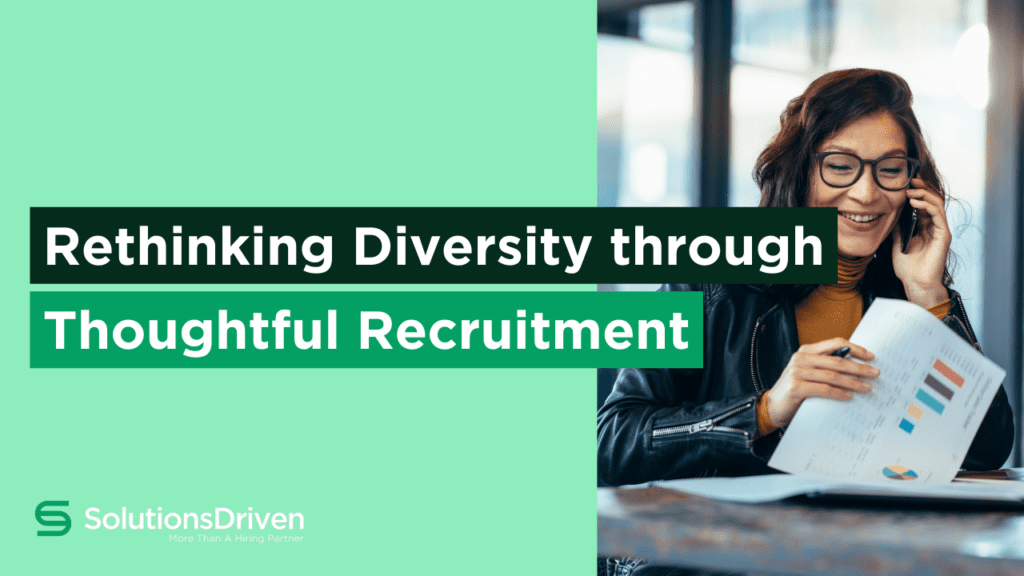To be the first to hear about our latest blogs, whitepaper releases, hiring enablement podcast episodes and get exclusive event invites, join our Exclusive Hiring Enablement Community.
Diversity in the workplace isn’t just about meeting a quota or highlighting buzzwords; it’s a strategic imperative. Companies that prioritise diversity see a host of benefits, including enhanced innovation, better decision-making, and improved employee satisfaction. However, achieving true diversity requires more than just lip service—it demands a fundamental shift in recruitment practices. In this blog post, we explore the concept of Thoughtful Recruitment as a powerful tool for building inclusive teams and fostering a culture of belonging.
Understanding Thoughtful Recruitment
Thoughtful Recruitment transcends surface-level diversity metrics and tokenism. At its core, it is about recognizing diversity as a fundamental value and integrating it into every aspect of the recruitment process. This approach emphasises the importance of quality over quantity, focusing not just on increasing the number of diverse hires but also on ensuring their meaningful inclusion and contribution within the organisation.
Challenges in Traditional Recruitment Methods
Traditional recruitment methods often perpetuate existing inequalities and biases within the workforce. One of the primary challenges is the lack of diversity in candidate pools, which can result from limited outreach efforts or unconscious biases in sourcing and selection processes. Unconscious biases, whether related to race, gender, age, or other factors, can influence hiring decisions within organisations.
Strategies for Implementing Thoughtful Recruitment
- Broadening Candidate Sourcing Channels: Organisations can diversify their candidate pools by tapping into a wide range of sources, including diversity-focused job boards, professional networks, and community organisations. By actively engaging with these channels, companies can access talent from underrepresented groups and expand their recruitment reach.
- Implementing Blind Recruitment Processes: Blind recruitment techniques, such as anonymising resumes and conducting skills-based assessments, help mitigate unconscious biases in the initial screening and evaluation stages. By removing identifying information, recruiters can focus solely on candidates’ qualifications and competencies, leading to fairer and more objective hiring decisions.
- Prioritising Inclusive Language and Messaging: Job descriptions and recruitment materials play a crucial role in attracting diverse candidates. By using inclusive language, avoiding gendered or biased terminology, and highlighting the organisation’s commitment to diversity and inclusion, companies can create a welcoming and inclusive environment for prospective applicants.
- Investing in Diversity Training: Providing comprehensive diversity training for recruiters and hiring managers is essential for fostering awareness, understanding, and accountability. Training programs can help individuals recognise and challenge their own biases, develop inclusive hiring practices, and create a more equitable recruitment process.
Overcoming Resistance and Pushback
Resistance to change is inevitable, especially when it challenges existing norms and practices. To overcome resistance and pushback, organisations must address common concerns and misconceptions surrounding diversity and inclusion initiatives. This may involve providing education and training, fostering open dialogue, and actively engaging with stakeholders at all levels of the organisation. Building support from leadership and demonstrating the business case for diversity are also critical in overcoming resistance and driving meaningful change.
Measuring and Evaluating Success
- Establishing Key Performance Indicators: Organisations should define clear and measurable KPIs for diversity and inclusion in recruitment, such as representation rates, retention rates, and employee satisfaction surveys. These metrics provide a quantifiable framework for assessing progress and identifying areas for improvement.
- Conducting Regular Audits and Assessments: Regular audits of recruitment practices, including data analysis and benchmarking against industry standards, help organisations identify gaps and opportunities for improvement. By systematically evaluating recruitment processes and outcomes, companies can ensure accountability and drive continuous improvement in diversity and inclusion efforts.
- Gathering Feedback from Candidates and Employees: Soliciting feedback from candidates and employees throughout the recruitment process provides valuable insights into their experiences and perceptions. By listening to their feedback and incorporating their perspectives, organisations can create a more inclusive and responsive recruitment environment.
Thoughtful Recruitment represents a paradigm shift in how organisations approach diversity and inclusion in the workplace. By rethinking traditional recruitment methods and embracing diversity as a strategic advantage, companies can build stronger, more innovative teams that reflect the diverse world we live in. The journey toward true diversity and inclusion requires a commitment to continuous learning, adaptation, and collaboration.
Are you ready to improve your hiring processes to ensure you’re building a diverse and inclusive workplace? Learn more about how to achieve your D&I goals by downloading our white paper, Beyond Quotas: Achieving True Diversity and Inclusion through Thoughtful Hiring Practices.
Alternatively, get in touch with us directly to discuss your D&I goals. Our talented consultants are experts in creating successful organisations and are here to help!





